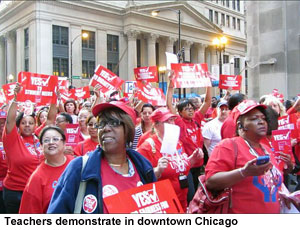
How parents and school board officials see their ideal teachers

FRONT PAGE
Site Search
About us
 

US teachers face scrutiny
US school discipline & civil rights
Character education
US college degrees
US school reforms
US education 2042
US mayors and schools
US public school integration
US military schools
America's most literate cities
Denver's pre-k programme
Banned books in US schools
Social services in US schools
World education
Mayors take over US city schools
Green schools

Worldwide | Elections | North America | Latin America | Europe | Asia | Africa |


























|
|
US state school teachers face
public performance scrutiny
By Tony Favro, USA Editor*
28 August 2012: The new school year is beginning in the United States, and millions of public (state) school students and their teachers are heading back to their classrooms. Students can look forward to having their progress tracked by report cards, and, for the first time, so can many teachers. Teacher evaluations are moving beyond the perfunctory “thumbs-up” or “thumbs-down” to more detailed - and more public - performance ratings tied to student performance.
• Chicago and New York
• Rigor and fairness
• Evaluation
Numerous studies over the past two decades conclude that student performance in school is tied more closely to teacher effectiveness than to any other factor. Good teachers produce good students, regardless of class size or length of school day or socio-economic background of the child. Moreover, students who must endure ineffective teachers may never catch up academically.
Measuring and maintaining teacher effectiveness would seem a fundamental requirement for schools that wish to excel, yet efforts to quantify teacher performance in the United States are novel, evolving, and controversial.
 Chicago and Chicago and
New York
The Chicago Teachers Union is threatening a teachers’ strike if a contract settlement isn’t reached with the City of Chicago, which operates the schools under the direction of Mayor Rahm Emanuel. Many issues are in negotiation, including teacher performance standards.
The stakes are high, and the entire US is watching. "Organized labor around the country is saying, 'What can we learn here?' And mayors are looking at Chicago and asking, 'Is Rahm going to pull this off?'" Timothy Knowles, director of the University of Chicago's Urban Education Institute told the Associated Press.
Mayors are attentive for obvious reasons. Poorly performing public schools are a major reason for the entrenched poverty and middle-class flight that afflict many US cities. Labor unions, for their part, exist to protect jobs. The traditional “satisfactory” or “unsatisfactory” rating system for teachers in American school districts meant that most teachers received tenure, or automatic job security, after as few as three years in the classroom.
The new rating systems link teacher performance and student performance. If students don’t score well on standardized tests, teachers face a series of escalating consequences from observation and feedback to mentoring and training to dismissal from employment. According to the New York Times, 55 per cent of third-year teachers in New York City earned tenure in 2012, down from 97 per cent five years ago before teacher evaluations based on student performance were in place. Teachers in New York City who were denied tenure can reapply after completed professional development training (or be removed after two consecutive ratings of ineffectiveness). Teachers with high ratings may be eligible for extra merit-based compensation.
Without negotiating with the teacher unions, Mayor Michael Bloomberg began implementing teacher evaluations based on students’ scores on standardized math and English tests soon after the New York State legislature granted the mayor control of New York City schools in 2009. Previously, the superintendent and school board determined school policy, not the mayor, and teacher evaluations were much less business-like.
They were also much more private.
In February 2012, a court, under the freedom of information law, allowed the release of evaluations for 18,000 New York City public school teachers to news organizations. “I believe that parents have a right to full disclosure when it comes to information about their child’s education,” Bloomberg said in a statement of support for the release of the data.
The New York State legislature disagreed with Bloomberg and blocked the release of additional teacher evaluations citing teachers’ privacy. A law introduced by the Governor and adopted by the legislature on the last night of the 2012 legislative session allows parents and guardians to see the evaluations of their children’s current teachers, but the general public can see evaluation data only after the names of teachers have been removed.
The law passed barely three months after New York State required all public school districts in the state to implement teacher evaluations by January 2013 or lose a share of state education aid.
The limited-disclosure law was a victory for teachers unions, who opposed the full disclosure of teacher appraisals, but it restricts the ability of parents and guardians to shop for good teachers for their children because evaluation data are available to parents only if they have a child in the teacher’s class. Parents, for example, don’t have the information to select the best-performing teacher for their child for the next school year.
Since the passing of New York state’s disclosure law conversations in cyber space - mirroring the form and content of a debate that is taking place across the country - focus on ways to bypass the law through information-sharing by parents about evaluations and posting them online for public access. Other topics being discussed in New York state and nationally include the passing of so-called parent trigger laws that allow parents to seize control of lower-performing public schools, ousting the teachers and administrators or bringing in private management firms.
New York City wasn’t the first city in the US to release teacher evaluation data to the public, but the publicity it garnered has crystallized national debate on the fairness of teacher evaluations.
Rigor and fairness
The idea behind setting high standards for teachers is not to make tenure difficult to earn or to shame individual teachers and administrators, but to break the cycle of underperformance in public schools, especially those in cities. The combination of children with cognitive or behavioral problems and teachers and administrators without the proper training is depressingly common in American urban public schools, as well as corrosive. If students need support which teachers and administrators are unable to give, the inevitable result is a school climate of frustration and underachievement at all levels.
The basic idea behind the evaluations is straightforward: ineffective teachers can be removed and effective teachers rewarded based on how well they teach, as measured by how well their students score on standardized math and English tests.
And here the question of the fair and accurate measurement of effectiveness enters.
Teachers and their unions protest that students’ test scores and overall academic achievement are the result of not only the quality of teaching, but also — and perhaps more importantly — the life experiences students bring into the classroom. Teacher evaluations based primarily on test scores and not on other ways teachers can attend to learning in the classroom and advance student growth, they say, have become an excuse for reducing payrolls and closing schools, rather than rewarding good teachers.
Adam Urbanski, vice president of the American Federation of Teachers, the largest teachers union in the US, calls the linking of punishments and rewards for teachers to student test scores “nonsense.”
“That approach presumes that teachers are just holding back, withholding excellent teaching, which is nonsense,” says Urbanski. “This assumes teachers are the problem. Teachers are the solution.”
The public and policymakers fully accept the teachers unions’ mantra that “teachers are the solution”, and are willing to take the risk that rigorous evaluations will markedly improve teacher quality. Seventeen states and the District of Columbia now use student achievement as the primary criterion in evaluating teachers, up from just four states in 2009.
Evaluation as a process
The teacher evaluation process may not be perfect in the eyes of the public, but it is perfectible.
No one learned much that was useful from the traditional pass or fail system of evaluations for public school teachers. Today - after two decades of data-driven innovations in the private business sector - Americans recognize evaluation as a process by which an organization can continuously clarify and sharpen its mission, improve measurement of its processes and their outcomes, and respond to what has been learned, only to reexamine it later, seeking an even better response.
Over the past 20 years Americans have become focused on value: a quality product for a reasonable price. In previous decades public frustration may have taken the form of marches and demonstrations in the streets. Today, Americans prefer a problem-solving approach. They have come to see evaluation as a key process in an organization - public or private - that continuously shapes and reshapes itself based on data. They see evaluation, in other words, as a promising way to add value to their lives and that of their children.
The process of evaluating teachers is evolving, but the American public is unlikely to step away from it, especially the reliance on standardized test scores. Through trial and error, parents and policymakers can be expected to work with local school districts and states to design evaluations systems that measure the right indicators so that teachers can manage their classrooms, administrators can manage schools, and students can manage their academic paths.
Parents have watched with frustration as their children have been the focus of experimentation in the schools. Now teachers in public school districts are also targets of experimentation, as befits a learning organization, and there is no turning back.
Recommended resources:
Janelle Duda and John Klofas, Evaluation Issues: A Practical Discussion for Small Agencies and Not-for-Profit Organizations, Center for Public Safety Initiatives, Rochester Institute of Technology, August 2012.
Dave McCleary, “Teacher Evaluation Bill Passed But Issues Surrounding It Remain”, Minority Reporter, June 25-July 1, 2012.
*Tony Favro also maintains the blog Planning and Investing in Cities.
|
|

|


































